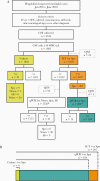Comparison of Culture, Antigen Test, and Polymerase Chain Reaction for Pneumococcal Detection in Cerebrospinal Fluid of Children
- PMID: 34469562
- PMCID: PMC8409532
- DOI: 10.1093/infdis/jiab073
Comparison of Culture, Antigen Test, and Polymerase Chain Reaction for Pneumococcal Detection in Cerebrospinal Fluid of Children
Abstract
Background: Sensitivity of culture for the detection of Streptococcus pneumoniae is limited by prior antibiotic exposure. Immunochromatographic test (ICT) is highly sensitive and specific for pneumococcal antigen detection in the cerebrospinal fluid (CSF) of meningitis cases. We determined the specificity and sensitivity of culture, ICT, and polymerase chain reaction (PCR) and the effect of antibiotic exposure on their performance.
Methods: CSF specimens from suspected meningitis cases admitted to Dhaka Shishu Hospital, Bangladesh, were tested using culture, ICT and PCR. Additionally, 165 specimens collected from 69 pneumococcal cases after antibiotic treatment were tested.
Results: Of 1883 specimens tested, culture detected 9, quantitative PCR (qPCR) detected 184, and ICT detected 207 pneumococcal cases (including all culture and qPCR positives). In comparison to ICT, sensitivity of culture was 4.4% and of qPCR was 90.6%; both were 100% specific. After antibiotic exposure, culture sensitivity plummeted rapidly; conventional PCR and qPCR sensitivity disappeared after day 6 and 20, respectively. ICT detected pneumococcal antigen for >10 weeks.
Conclusions: While culture provides the most information about bacterial characteristics, in high antibiotic exposure settings, ICT exhibits maximum sensitivity. We recommend culture and ICT as mainstay for pneumococcal diagnosis and surveillance; qPCR can generate additional molecular data where possible.
Keywords: ICT; antibiotic exposure; diagnostic; meningitis; pneumococcal vaccine; pneumococcus; surveillance; vaccine preventable.
© The Author(s) 2021. Published by Oxford University Press for the Infectious Diseases Society of America.
Figures



References
-
- O’Brien KL, Wolfson LJ, Watt JP, et al. ; Hib and Pneumococcal Global Burden of Disease Study Team . Burden of disease caused by Streptococcus pneumoniae in children younger than 5 years: global estimates. Lancet 2009; 374:893–902. - PubMed
-
- von Gottberg A, de Gouveia L, Tempia S, et al. ; GERMS-SA Investigators . Effects of vaccination on invasive pneumococcal disease in South Africa. N Engl J Med 2014; 371:1889–99. - PubMed
-
- Waight PA, Andrews NJ, Ladhani SN, Sheppard CL, Slack MP, Miller E. Effect of the 13-valent pneumococcal conjugate vaccine on invasive pneumococcal disease in England and Wales 4 years after its introduction: an observational cohort study. Lancet Infect Dis 2015; 15:535–43. - PubMed
-
- Whitney CG, Farley MM, Hadler J, et al. ; Active Bacterial Core Surveillance of the Emerging Infections Program Network . Decline in invasive pneumococcal disease after the introduction of protein-polysaccharide conjugate vaccine. N Engl J Med 2003; 348:1737–46. - PubMed
Publication types
MeSH terms
Substances
LinkOut - more resources
Full Text Sources

